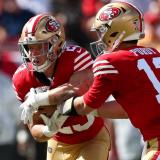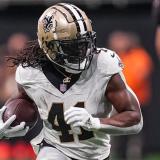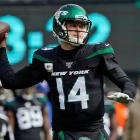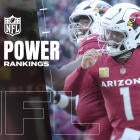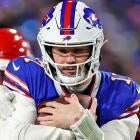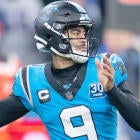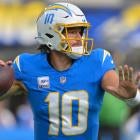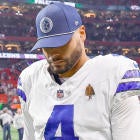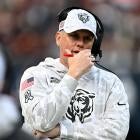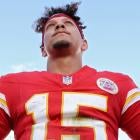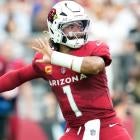EAST RUTHERFORD, N.J. -- Daniel Jones and Sam Darnold squared off in a New York Giants vs. New York Jets game that only happens once every four seasons — assuming we remain without a Subway Super Bowl — in a quarterback matchup that both franchises hope will resurface when they next meet in 2023. Although some will get caught up in the buzzier storyline — will either team move on from each respective head coach — Pat Shurmur and Adam Gase — the only topic of long-lasting importance is the development of each first-round quarterback. While both teams might not feature Shurmur and Gase next time around, the Jets' 34-27 win over the Giants should give fans of both teams hope that the next time the all-New York matchup is on the schedule, both Darnold and Jones will be the respective starting quarterbacks.
Darnold got the first laugh in the battle for New York, but Jones' ability to get the Giants out of third-and-long situations with his accurate ball placement helped them overcome a 14-point deficit to briefly take a lead in the second half. However, when pass protection predictably broke down for both teams, it was Darnold's ability to create big plays with accurate ball placement while on the run that proved the difference.
Before diving into analysis of each prospective franchise quarterback's performance in this game, it's important to set the stage. Both Jones and Darnold are playing with a short deck in 2019 when it comes to their supporting cast. Darnold has the advantage of live game action experience — the second year is supposed to be when quarterbacks make a big jump. However, this advantage hasn't played out from a production standpoint thus far in 2019.
We'll start by breaking down arguably any quarterback's most important friend — his offensive line.
Pass Protection
When it comes to pass protection, neither the Jets nor Giants were very stout entering the Week 10 matchup. According to Football Outsiders, the Jets rank dead last in pass protection with an adjusted sack rate of 12.0%. The Giants fare a little better, ranked No. 22 with a 7.9% adjusted sack rate. Normally, we would give the Giants the edge here. However, the Giants were without starting right tackle Mike Remmers and starting center Jon Halapio for the first time all season in Week 10 against the Jets. A pair of former undrafted rookies (Spencer Pulley, Nick Gates) replaced Halapio and Remmers, respectively.
In this matchup, both teams struggled in pass protection. The Giants, who were down to three reserve offensive linemen after Nate Solder (concussion) left the game in the first half, dealt with major pass protection issues in the final two quarters. Jones was sacked 6 times and was under constant duress. Darnold was sacked twice, but the Giants were able to get pressure after making halftime adjustments -- Darnold beat several of these with his legs and converted big plays while throwing on the run.
Run Blocking
Both teams have struggled to find a groove in their run blocking schemes. Saquon Barkley has never really looked totally comfortable running behind Shurmur's scheme that incorporates a heavy dose of inside zone. At Penn State, Barkley thrived behind a power and gap scheme. On the flip side, Le'Veon Bell has also struggled to find his niche running behind the Jets' offensive line after operating behind a unique blocking scheme for his entire career with the Pittsburgh Steelers.
As far as the grades go, entering this week, Football Outsiders ranked the Giants No. 22 and the Jets No. 30 overall in run blocking.
In this matchup, both teams predictably struggled to create any movement on the ground. Barkley became just the second running back in the last 40 seasons to finish a game with one rushing yard or fewer on at least 12 rushing attempts. Barkley finished with one yard on 13 carries. On the flip side, Bell wasn't much better with 34 yards on 19 carries (1.9 yards per carry). Neither team's run game helped their quarterback.
After the game, the Giants rookie refused to use their dormant run game as an excuse.
"I think all phases of the game complement each other," Jones said. "We have to do a better job in the pass game finding completions and moving the ball, and that helps everyone. As an offense, we have to be able to attack in a lot of different ways. Each of the phases will take pressure off of others. That goes for the pass game. If we can move it consistently, I think some of the runs will open up also."
Player-speak aside, the Giants' passing game threw for 300 yards -- more than enough to "open up" a run game that has looked dysfunctional while continuing to rely heavily on the inside-zone blocking plays.
Skill Position Players
Entering the 2019 season, it appeared the Giants had a lot more firepower at the skill positions than the Jets. However, entering this game, the Giants were without Jones' favorite two targets — tight end Evan Engram and wide receiver Sterling Shepard — both were ruled out earlier in the week with injuries. In Jones' breakout debut back in Week 3, Engram and Shepard accounted for 13 catches, 213 yards, and two touchdowns. The Giants didn't have much of a contingency plan for Engram's absence at tight end, but remaining healthy wide receivers Golden Tate and Darius Slayton match up evenly with the Jets' receiver corps. The Jets returned second-year tight end Chris Herndon for this game and most would call the current version of Saquon Barkley (playing through an ankle sprain) vs. Le'Veon Bell a wash.
The Stats (prior to the matchup)
When it comes to evaluating quarterback play, chasing box score stats is the laziest form of analysis. However, it's also sometimes the only tangible evidence we have to work with. Entering their Week 10 matchup, here's a look at how Jones and Darnold have fared:
Jones: 7 games started, 161 of 257 (62.6%), 1,676 passing yards, 11 TDs, 8 INTs, 6.5 Y/A, 51.0 QBR, 188 rushing yards (two TDs)
Darnold: 5 games started, 110 of 174 (63.2%), 6 TDs, 9 INTs, 6.2 Y/A, 28.3 QBR, 0 rushing yards (0 TDs)
By The Numbers
When the All-22 coaches tape is available later this week, we will circle back to provide analysis on how each quarterback performed based on the tape, but first, let's break down how these two quarterbacks performed on paper and in some key metrics.
- Jones: 26 of 40 (65%), 308 passing yards, four TDs, zero INTs; three carries, 20 rushing yards, one fumble lost
- Darnold: 19 of 30 (63.3%), 230 passing yards, one TD, zero INTs; three carries, 25 rushing yards, one TD
Ball Placement
Jones: If you're looking for one standout trait for the Giants rookie quarterback through his first eight games, it is undoubtedly his ball placement. Jones has shown the ability to throw the ball in spots where his wide receivers can create the maximum amount of yardage after the catch -- throwing what's known as a runner's ball. Despite being constantly thrown into third and long situations, Jones' ball placement was pinpoint on deep comebacks, outs, and in-breaking routes to keep the chains moving. The Giants converted 8 of 18 third downs, including six attempts of seven yards or longer -- one where he ran for 11 yards to pick up the first down, one where he drew defensive pass interference, and four completed passes. He gets knocked for his subpar ball placement on the final two Giants' possessions when the Jets' pass rush got pressure.
Grade: A-
Darnold: Darnold didn't throw outside the numbers anywhere near as often as Jones, with his first two scoring drives consisting mostly of short throws over the middle. He also missed a wide-open long touchdown on a flea flicker from a completely clean pocket where his intended receiver had two steps of separation. He gets knocked for that, but at the same time, his ability to throw with perfect ball placement while rolling to his right created massive chunk-yardage gains in the second half. They were the difference in the win.
Grade: B+
Mental Processing
Jones: Darnold has played more than double the games of Jones at the NFL level, and that context is to be considered, but the rookie had multiple plays where he didn't process fast enough and took a sack on the play. On the flip side, he converted the aforementioned eight third downs -- the majority in third-and-long -- including two conversions where he worked through his full slate of progressions.
Grade: C+
Darnold: The second-year Jets quarterback seemed to be processing the Giants' defensive scheme a lot better before defensive coordinator James Bettcher made second-half adjustments. However, Darnold's ability to extend plays with his legs made up for it. The Jets went just 4 of 13 on third-down conversion attempts and this is reflected in his grade.
Grade: C+
Ball Security
Jones: The fumbling issue has become the key issue for the Giants' rookie quarterback. Jones fumbled three times in this game and was lucky enough to only lose one. However, on the one lost fumble, Jets safety Jamal Adams ripped it out of his hand and returned it for a touchdown. Although Jones' plus ball placement prevented him from throwing many potential interceptions (with the exception of a sideline toss to Slayton), his inability to hold on to the football has haunted the Giants. After the loss, Jones didn't have much to say about the Jets' fumble return for a touchdown.
"Just trying to get the ball out and didn't do a good job of holding onto it with him there," Jones said.
Grade: D+
Darnold: The Jets quarterback converted an early third-down conversion on the opening drive into a tight window where Giants safety Jabrill Peppers nearly jumped into for an interception, but other than that, he did an excellent job keeping the ball away from the Giants. The Jets finished with zero turnovers
Grade: A
Big-time Throws
Jones: The two biggest passing plays of the game (Slayton for 39, Tate for 61) came mostly after the catch, but Jones did an excellent job dialing up deep comebacks on the far hash (to his right) to keep the chains moving in multiple long distance-to-go situations (on both second and third downs). However, he just missed Tate on a broken play rolling to his right that would've resulted in a long touchdown connection.
Grade: B
Darnold: Although Darnold missed the wide-open flea flicker touchdown early, and although he didn't connect on many big plays from within the pocket, his ability to extend the play by rolling out with his feet led to multiple long gains in the second half including a 47-yard connection to Demaryius Thomas and a 25-yard completion to Jamison Crowder. These plays made the difference.
Grade: B+
Final Grades
Jones: The rookie quarterback had his third game with 300+ passing and his second in the last two weeks with 300+ passing and four touchdowns. His ball placement was excellent until the final two possessions despite having no semblance of a rushing attack to keep the Jets' defense honest. Jones did all this without his two favorite targets in the passing game (Engram, Shepard) and with two undrafted players starting at left tackle and right tackle -- in addition to playing with a reserve at center. However, his inability to process plays fast led to multiple sacks when he held onto the ball for too long including an extremely costly fumble returned for a touchdown.
Final Grade: B-
Darnold: Although the Jets quarterback wasn't tasked with throwing the football downfield often, he gets knocked for missing a wide-open flea flicker on the should-be touchdown. Darnold more than made up for it in the second half by creating big chunk-yardage passing plays while rolling to his right -- both by design and out of necessity. Darnold outdueled Jones with his ability to process his team's porous pass protection faster than his counterpart and respond to it with big plays outside of the structure and off-script.
Final Grade: B+




